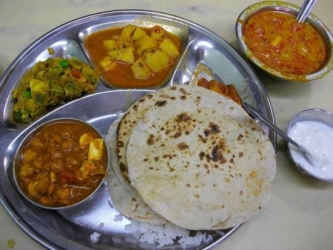Hindu Eating and Diet | 12
Eating and Diet
Perhaps one of the most important areas of Hindu life is food. The treatises on dharma spend the most amount of time discussing the issue of marriage, and the second area of interest is food:
What is consumed, who consumes it, who prepares the food, when it is done, how much is eaten, with whom one eats, what direction one faces when one eats, and more details are all addressed with great detail—but are often negated in the contexts of faith and devotion.
Food regulations may differ not only between the various castes and communities of the Hindu traditions but also by region, gender, the stages of a person’s life, the times of the year, the phases of the Moon, the ritual calendar, and an individual’s obligations.
Contrary to the perception of many Westerners, most Hindus are not vegetarians. Whether a Hindu practices vegetarianism is determined by his or her membership in a specific community or caste.
The cow is seen as a nurturing mother. Sometimes cows are considered the “residence” of the goddess Lakshmi. Hence, most Hindus in the last two millennia have tended not to consume beef.
There are regular periods of fasting and feasting in the Hindu calendar, and these periods differ for each community:
Many Vaishnavas (followers of Vishnu) have typically fasted or avoided grain on Ekādaśī day (the 11th day of the waxing or waning Moon).
Others fast during specific festival seasons such as Navarātri.
Some fasts are specific—refraining from grains, rice, salt, and so on for a period of time.
Men and women sometimes fast for half a day or for several hours on days when they have performed rituals to the ancestors.
For many Hindus it is not enough just to be a vegetarian; food, like many other material substances, is said to have 3 qualities: These are sattva (purity); rajas (passion, energy, movement); and tamas (sloth, stupor, rest).
Thus, some Hindu communities refrain from having onions and garlic because they are said to have a preponderance of rajas and tamas.
Several vegetables are also prohibited for similar reasons; for example, food that has been tasted by others and leftover food are considered to be ritually polluted and are also prohibited.
While there are hundreds of restrictions on food, there are certain devotional contexts where food that can be considered ritually polluting is made acceptable because of a devotee’s faith:
There are several Hindu narratives about how prohibited food was offered to the deity and it was accepted because the devotee offered it with love.
In many temples ritual food is offered to the deity and then distributed to the worshipers as divine favour (prasāda):
For more than a thousand years devotees have endowed land and monies to temples so that the revenue from them could be used for the preparation of food and then distributed to the pilgrims.
Many families even now sponsor feasts or donate food in temples to celebrate birthdays or in memory of family members.
Right eating is not just what a person can eat or avoid; in the texts on dharma as well as in orthodox in practices houses, it involves issues such as:
the caste and gender of the cook (preferably a high-caste male or any woman, except at times when she is menstruating); the times a person may eat (for example, twice a day and not during twilight); and not eating food cooked the day before.
The greatest amount of discussion in the Dharma Śāstra texts is spent on forbidden foods, which varied in different time periods and between authors:
It is generally agreed that most people ate meat, even beef, possibly up to the beginning of the Common Era.
It is a matter of some controversy whether Indians ate beef during the time of the Vedas and whether the cow was a protected animal; however, it is fairly well accepted that most Indians ate other kinds of meat and fowl then.
